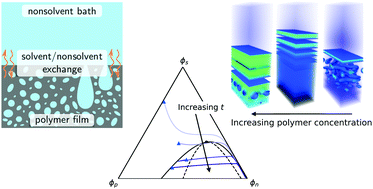Mass-transfer driven spinodal decomposition in a ternary polymer solution†
Abstract
Nonsolvent induced phase separation (NIPS) is a widely occuring process used in industrial membrane production, nanotechnology and Nature to produce microstructured polymer materials. A variety of process-dependent morphologies are produced when a polymer solution is exposed to a nonsolvent that, following a period where mass is exchanged, precipitates and solidifies the polymer. Despite years of investigation, both experimental and theoretical, many questions surround the pathways to the microstructures that NIPS can produce. Here, we provide simulation results from a model that simultaneously captures both the processess of solvent/nonsolvent exchange and phase separation. We show that the time it takes the nonsolvent to diffuse to the bottom of the film is an important timescale, and that phase separation is possible at times both much smaller and much larger than this scale. Our results include both one-dimensional simulations of the mass transfer kinetics and two- and three-dimensional simulations of morphologies at both short and long times. We find good qualitative agreement with experimental heuristics, but we conclude that an additional model for the vitrification process will be key for fully explaining experimental observations of microstructure formation.



 Please wait while we load your content...
Please wait while we load your content...
